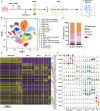Communication Pattern Changes Along With Declined IGF1 of Immune Cells in COVID-19 Patients During Disease Progression
- PMID: 35095832
- PMCID: PMC8795624
- DOI: 10.3389/fimmu.2021.729990
Communication Pattern Changes Along With Declined IGF1 of Immune Cells in COVID-19 Patients During Disease Progression
Abstract
The emergence of severe acute respiratory syndrome coronavirus 2 (SARS-CoV-2), which causes the coronavirus disease 2019 (COVID-19) pandemic, represents a global crisis. Most patients developed mild/moderate symptoms, and the status of immune system varied in acute and regulatory stages. The crosstalk between immune cells and the dynamic changes of immune cell contact is rarely described. Here, we analyzed the features of immune response of paired peripheral blood mononuclear cell (PBMC) samples from the same patients during acute and regulatory stages. Consistent with previous reports, both myeloid and T cells turned less inflammatory and less activated at recovery phase. Additionally, the communication patterns of myeloid-T cell and T-B cell are obviously changed. The crosstalk analysis reveals that typical inflammatory cytokines and several chemokines are tightly correlated with the recovery of COVID-19. Intriguingly, the signal transduction of metabolic factor insulin-like growth factor 1 (IGF1) is altered at recovery phase. Furthermore, we confirmed that the serum levels of IGF1 and several inflammatory cytokines are apparently dampened after the negative conversion of SARS-CoV-2 RNA. Thus, these results reveal several potential detection and therapeutic targets that might be used for COVID-19 recovery.
Keywords: COVID-19; IGF1; communication pattern; immune cells; single-cell sequencing.
Copyright © 2022 Zhao, Liu, Shao, Zhou, Chen, Xia, Wang and Yang.
Conflict of interest statement
The authors declare that the research was conducted in the absence of any commercial or financial relationships that could be construed as a potential conflict of interest.
Figures





References
-
- WHO . Available at: https://covid19.who.int/.
-
- C.C.f.D.C. Epidemiology Working Group for Ncip Epidemic Response, and Prevention . The Epidemiological Characteristics of an Outbreak of 2019 Novel Coronavirus Diseases (COVID-19) in China. Zhonghua Liu Xing Bing Xue Za Zhi (2020) 41:145–51. doi: 10.3760/cma.j.issn.0254-6450.2020.02.003 - DOI - PubMed
Publication types
MeSH terms
Substances
LinkOut - more resources
Full Text Sources
Medical
Miscellaneous

